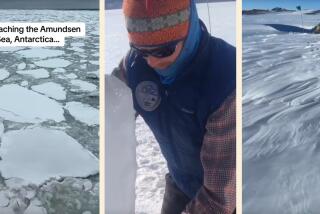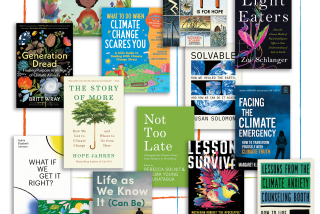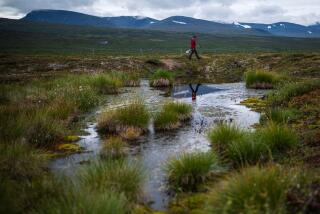Opinion: I am a diver who documents climate change in the Arctic. And I am running out of time
- Share via
Nearly 20 years ago, I led a National Geographic diving team that made the first cave dives inside the largest floating piece of ice ever seen on our planet. The B-15 iceberg had calved from an ice shelf in Antarctica, and we were moved to explore the inside of what was regarded as a potential harbinger of global climate change. While I wrote the script for the accompanying documentary film, “Ice Island,” people cautioned me not to use politically charged terms such as “climate change” and “sea-level rise.”
Scientists recently announced that the polar ice is collapsing faster than predicted. And every week, the headlines are filled with new warnings of accelerating ocean-level rise. Climate change is happening. I have dived and documented it firsthand for decades. How we plan for it and adapt to it in the next few years will determine the future of our civilization. That’s what draws me to scuba dive under the ice in the northern reaches of my homeland, Canada.
According to the U.S. National Snow and Ice Data Center, the Arctic is transforming more rapidly than anywhere else on Earth, with temperatures rising at twice the rate seen elsewhere. I am caught up by the urgency to document Earth’s fragile ice-covered geography — the cryosphere — hoping that my photos and films will bring attention to the vulnerable and fleeting ice. Nobody can be certain when the Arctic sea ice will be gone, but scientists agree that we are on a precarious downward spiral. The loss of nearly all Arctic sea ice in late summer seems inevitable, and an ice-free Arctic Ocean will probably arrive within decades, if not sooner.
For the last two years, my Arctic expeditions have been undertaken earlier each season. The frozen surface of the Northwest Passage that provides the base for our summer camps melts sooner each succeeding year. Even more worrying is that the ice is thinner each year. The Inuit call the sea ice “the land” because it offers freedom to travel, visit family, hunt and pass along cultural practices to the next generation. Time on “the land” is shorter and more dangerous every year. Will the Inuit have to abandon their traditional wooden sleds, called qamutiks, and snowmobiles for small boats?
The complex Arctic food web is declining with the shrinking sea ice, disrupting the tenuous balance of food security for marine life and people alike. For a society that has always lived in balance with nature, permafrost melting, sea-level rise, erosion and an increase in stormy weather pose risks. With the Arctic becoming more navigable and accessible, resource speculation is on the rise. Oil, gas and shipping industries are jockeying to snag new routes and drilling rights in the open water. These activities will indelibly alter the complexion of the Arctic and bring new threats to an otherwise pristine sanctuary.
On a recent Arctic expedition, I got a firsthand look at the transient nature of the melting pack. Pouring rain created shin-deep rivers that ran through our tents in camp. While traveling on the ice, the qamutik sled hooked to my guide’s snowmobile swung sideways, spraying a rooster tail of slush in the way that a boat creates a wake. We turned abruptly to run alongside a wide crack in the ice. A mile closer to shore, we found a spot where our snowmobile could bridge the gap. My guide unhooked the qamutik and revved the engine to full speed, then flew across the open water to the other side. He threw us a rope and pulled the longer sled across.
We resumed the race to a pinnacle on the horizon — an iceberg that had broken free from the glaciers of Greenland and traveled across the Davis Strait to become locked in the sea ice. A small strip of open water near the berg showed that this frozen monument was struggling to be released from the grips of the ice floe. Freshwater cascaded down the face of the ice in streaming rivulets that furrowed the surface in vertical channels. We needed to dive immediately. The berg was an ideal spot for an exploration dive, but it wouldn’t last long before breaking away and melting into the ocean.
I settled in the water and pushed away the slush that obscured my view, dropping through a blurry zone of mixing fresh and saltwater. Long runners of algae flapped horizontally in the current, held fast to the undersurface of the ice. This algae and other nutrients contained within the ice will feed the phytoplankton and zooplankton that serves as the base of the Arctic food chain. Bottom dwellers such as anemones, sponges and halibut will, in turn, feed other fish and marine mammals such as belugas, narwhal and bowhead whales.
The surface of the ice was dimpled and fluted, carved by the undersea currents that pulled my safety rope taut. Descending along the bluish frozen facade, I observed virtual layers of time that could date this ice back 10,000 or more years. Each stripe represents a season of snowfall on Greenland. Some strips were transparent, others filled with gray dust, perhaps evidence of some ancient volcanic eruption. Small air bubbles within the ice fizzed and drifted upward as they dissolved.
Deeper, a colorful carpet of orange kelp fronds draped itself over a miniature garden of crustaceans and sponges. I looked upward in the glaciated cathedral to see my dive partner falling toward me on a silver stream of bubbles. Her silhouette glided through the cerulean depths as she worked to pull her safety rope in my direction.
I am grateful for the opportunity to preserve images of this endangered kingdom, but what will happen to the people and animals of the North?
Within 24 hours of our dive, the giant monument of ice we explored broke away from the floe edge and started its journey south. Within weeks it would tumble, turn and dissolve , leaving a wake of nutrients and fresh water and adding to the slow rise of the world’s oceans.
And then it would be gone forever.
Jill Heinerth, author of “Into the Planet: My Life as a Cave Diver,” has spent more than 30 years documenting and researching submerged caves around the world.
More to Read
A cure for the common opinion
Get thought-provoking perspectives with our weekly newsletter.
You may occasionally receive promotional content from the Los Angeles Times.










